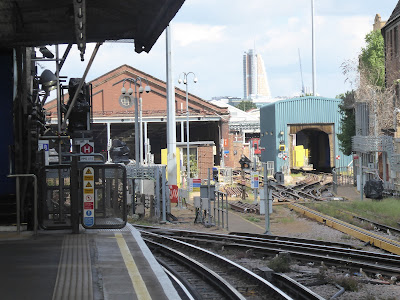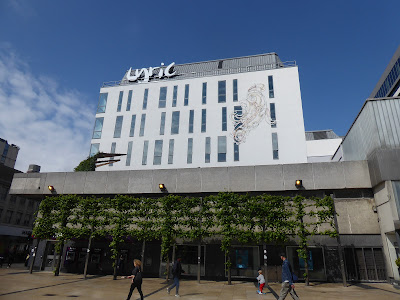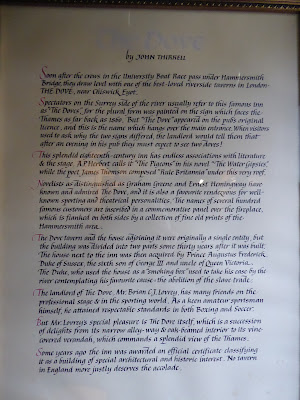 Here I am at the last station on the Circle Line. It has taken me 21 months to photograph, research and write about the 31 stations I visited on this, the yellow line on the tube map (I had already posted about the other four stations which are also on other lines). In length the line measures 17 miles but I will have walked many more. I calculate that I walk at least 5 miles per station as I walk up and down the surrounding streets. This has been a very interesting line as it circles Central London and is closest to many of the major tourist areas. On the down side it has been difficult to get the photos I've wanted because of the crowds.
Here I am at the last station on the Circle Line. It has taken me 21 months to photograph, research and write about the 31 stations I visited on this, the yellow line on the tube map (I had already posted about the other four stations which are also on other lines). In length the line measures 17 miles but I will have walked many more. I calculate that I walk at least 5 miles per station as I walk up and down the surrounding streets. This has been a very interesting line as it circles Central London and is closest to many of the major tourist areas. On the down side it has been difficult to get the photos I've wanted because of the crowds.This last station, Hammersmith, is not a main tourist destination but there is still much to see of interest. There is not one but two stations called Hammersmith. One for the Circle and Hammersmith and City lines and the other one which serves the District and Piccadilly Lines which I will photograph when visiting the District Line at a future date. This station was opened in 1864 by the Hammersmith and City railway.
This station is a terminus, so I was taking this photo of a train just leaving the station when one of the rail workers approached and said photography was not allowed. I mentioned the fact that this is the 105th station I have photographed and nobody has mentioned, nor have I have seen signs, that photography is not allowed. He told me I was supposed to ask permission first. So I requested permission from Mr Jobsworth and was told that was OK and I could take as many photos as I wanted!

As I alighted from the train I noticed this ghost writing on the brick wall running alongside the station. I had to wait until my train had left the station on its way back into Central London before I could get a better view. The writing is advertising the dance times and prices at the Hammersmith Palais de Danse. Built as a tram shed in 1910, it opened its doors as a dance hall in 1929, the first palais de danse to be built in Britain. After the war it became a popular music venue especially for jazz. It became known as the Hammersmith Palais and in later years many famous groups performed there such as The Beatles, The Who, David Bowie, Rolling Stones and the Clash. It finally closed in 2007.
The current station was opened in December 1868 replacing the original station which was built a little to the north of here.

Across the road from the station is the William Morris pub named after the famous Arts and Crafts designer who lived in Hammersmith in the late 19th century.
The road led me round to the Lyric Square and theatre. The top two floors of this concrete block house is the Lyric theatre with an interior that dates back to 1895. The original theatre was demolished in 1969 but the auditorium was preserved and reconstructed inside the new theatre in 1979.
King Street, the main shopping street in Hammersmith.
There are some large public houses at this end of the High Street. The Swan pub began life as a coaching inn on the road west out of London. The current building was built at the end of the Victorian era in 1901.
St Christopher's Inn was built in 1911 and is now another Grade II listed building in the area. It is no longer a pub but still an inn of sorts, being a backpackers hostel.
The Hammersmith flyover.
Rather than fight with the traffic I crossed via the subway, which is brightly decorated with its mixture of tiles and mosaics.
From the other side of the road you can see St Paul's church in the shadow of the flyover. The church is a Grade II listed methodist church that originally dates from the 17th century. However as Hammersmith rapidly developed in the 19th century due to the arrival of the railway it was decided the church was not big enough to accommodate the growing population and a new church was built on the same site. When the Hammersmith flyover and the Great West Road were built in 1957-61 the church lost a large part of land which included graves.
On the other side of the flyover I walked past the Apollo theatre from where 'Britain's got Talent show' was being broadcast live that evening. It was built as the Gaumont Palace in 1932, seating 3560. It operated as a cinema until 1984 and then it became an entertainment venue. The building now has Grade II status and is one of the few original cinemas that retained its working cinema organ.

A short walk from the Apollo brings you to the River Thames and Hammersmith Bridge. The bridge is currently closed to vehicles but cyclists and pedestrians can still cross the river via the bridge. Hammersmith Bridge was the first suspension bridge built over the River Thames. A feat of Victorian engineering, it was designed in 1887 by Sir Joseph Bazalgette. A combination of cast iron, wrought iron and 999 lindividual wooden plates. It is also London's lowest bridge, with a water clearance of just 12 ft at high tide. As the weakest bridge over the Thames, weight restrictions have been in place since 2015. From then on weekly safety checks have taken place. In April of this year hairline micro fractures were discovered in the iron casings around the pedestals of the bridge and it was closed to vehicles. Apparently cast iron is brittle and prone to shattering. Hence this is the only bridge of its kind in the country and one of only two in the world (the other one is in Budapest). The bridge will be closed for a complete refurbishment which will take years to complete.
I couldn't get a decent photo of the bridge because of the closure so I have included these photos which I took a few years ago when I walked the Thames path. This is one of my favorite Thames bridges. I used to travel across this bridge most days when I worked in Hammersmith in the early 70s. Hammersmith Bridge has been bombed three times: the IRA in 1939, the Provisional IRA in 1996 and by the Real IRA in 2000. The first bomb was spotted by a member of the public who noticed a smoking suitcase on the bridge and threw it into the river. The second time in 1996, the detonators went off but didn't ignite the explosives and the third time it did explode and the bridge was closed for three weeks for repairs.


Steps from the bridge bring you down onto the Thames Path. By the side of the steps is this ornate Victorian drinking fountain.
I turned right onto the Thames path and the Lower Mall with its beautiful 18th century houses and rowing clubs. There are a number of blue plaques on the buildings.

George Devine lived here from 1956-65.
There are a number of Rowing clubs along this stretch of the Thames. Initially rowing was a means of transporting goods more easily than using the poor tracks and roads. The rowers used to gamble on the speed of their boats. The idea of betting and racing these boats caught on with the upper classes and boys and men from Eton College and Oxford University rented the boats to try rowing and eventually racing for themselves. This club was formed in 1981 with the merger of two clubs, Kensington RC and Auriol RC. Kensington was one of the early amateur rowing clubs, founded in 1872 by men associated with the Kensington and West End stores. Auriol was founded in 1896 by Reverend Propert as a Christian rowing club. This building used to house a Victorian boathouse - Biffen's which would rent boats out to the local rowing clubs. It went out of business after WW2 and the Auriol RC bought the building leasing the upper half to Kensington RC. They decided to amalgamate in 1981 and rebuilt the building in 2004.


Looking back towards Hammersmith Bridge. This is a popular part of the river especially during the Summer with the riverside pubs and also as a viewing point when watching the University boat race between the Oxford and Cambridge University Rowing teams.
Another of the rowing clubs on the Lower Mall.

Westcott Lodge c.1746 was the vicarage to St Paul's church and later became a registry office.
Furnivall Gardens cover the site of 'Little Wapping', Hammersmith's old wharf and industrial area. During the 18th and 19th centuries the area became increasingly industrial served by Thames sailing barges. The area was destroyed by bombing during WW2 and these gardens were laid out in 1951 for the Festival of Britain. They were named after Dr F J Furnivall a supporter of adult education who founded the National Amateur Rowing Association in 1891.
In 1677 the Quakers established a meeting house and worshipped there for over two centuries until the house was destroyed by the bombing in July 1944. The Garden of Remembrance commemorates the Quaker Meeting House and burial ground once located at this site.
Dove Pier previously known as Hammersmith Pier was constructed in 1951 for the Festival of Britain. Pleasure steamers provided regular services to the centre of London and Kew Pier upstream. It has been restored and enlarged to provide residential moorings.

The Dove public house in the Dove passageway was originally a coffee house in the early 18th century.
Decided to stop here for some refreshments and to absorb the atmosphere of this 18th century pub.
It was before the lunch time rush so I had the pleasure of the tiny lounge bar all to myself.
Above the fireplace is a plaque with the names of many people from stage, screen and literature who have enjoyed a drink here.

A view from the balcony of the pub overlooking Dove Pier.
The pub has another claim to fame as the birth place of the song 'Rule Britannia' written by John Thomson, a frequent visitor to the Dove.
Beside the house in the coach house and in the basement are the headquarters of the William Morris Society. The house itself dates back to 1780 and prior to Morris was the home of Sir Francis Ronalds who constructed the first electric telegraph in the garden.

I turned right here away from the Thames and up to the Great West Road.
Across the road is Hammersmith Town Hall. Built between the wars it was given Grade II status in 1981 because it was regarded as a good example of a town hall built between the wars reflecting both modern and classical elements. However the front of the building on King Street is a boring modern extension built in the early 70s. There has been much controversy about the extension and planning permission has recently been granted to demolish the extension and develop the front of the Town Hall with a new community square. Something to look out for in the future.

The wall is carved at either end with colossal carved heads depicting Father Thames, sculpted by George Alexander.

I walked back to the tube station via a housing estate.
The tube travels over this bridge over Cambridge Grove.. I don''t think I have ever walked under a rail bridge that was so low it was possible to reach up and touch it.
Back to the station and the tube home, ending my 'Above the Underground' visits to the Circle Line.
sharing with Our World Tuesday













































It's nice to see some of the old buildings still in amongst the modern ones.
ReplyDeleteI always enjoy our excursions - buildings and history!
ReplyDeleteAside from a couple of privately operated underground stations here where photography is not allowed, all other stations are considered public space and you have every right to take photos. At times people to get challenged by over zealous staff, and the smart ones will have on them a small print out of the laws to show.
ReplyDeleteThe William Morris Hotel is a very odd looking pub. Lots of claims to fame for Hammersmith, a part of London I haven't been to.
There's lots of interesting stuff there. That station is older than my city!
ReplyDeleteWell still lots toes and a lot of history here. The old pub sounds so interesting. Well done completing another line. Your determination and commitment is to be admired. You should publish the blogs into a book. Blog2Book is a program that is easy to use.
ReplyDeleteWow - so much history! And herons! Who knew!
ReplyDeleteCongratulations on your blogging marathon! Hammersmith is one Tube station I do know, but as before you show us what I have never noticed! It is great to travel through your keen eyes for interest. Thank you.
ReplyDeleteWren x
Hello, Wow, there is so much to see there. I love the Bridge and heron. I would love to visit the Dove and Swan Pubs. The architecture and carvings, the coat of arms are all beautiful. Wonderful tour and photos. Wishing you a happy day and a great new week!
ReplyDeleteI find the history so facinating and so enjoy these ventures. I was surprised to recognize so many of the actor's names on the plaque. I wonder how many people pass the same places you do but are unaware of the interesting history of the place? Well done.
ReplyDeleteYou deserve a celebration for achieving that goal. Your neck of the woods is seeped in such fascinating history, including earlier history and all the wonderful rock groups that sprung out of Britain. The ghost writing is the best!!
ReplyDelete...and your sharing those months with us has been and incredible journey...I enjoyed all I've seen and appreciate it. Thank you for taking me with you.
ReplyDeleteAbsolutely fascinating, and so well researched - as all your posts about tube stations and their neighborhoods are. It's astonishing how much history there can be in a relatively small area. I used to visit Hammersmith in the early '80s, and briefly worked in King Street, but about 95% of this was new to me. I admire your patience with Mr Jobsworth!
ReplyDeleteFantastic architecture! Love the variety.
ReplyDeleteThank you for this comprehensive guide. I enjoyed the history and various different classical architecture.
ReplyDeleteWonderful photo series tour!
ReplyDeleteHappy Day to you ^_^
Que bonito.....
ReplyDeleteI enjoy these so much! Thanks for fixing the link. I am familiar with the “other” Hammersmith station but not this one. You’ve made me wish i explored more of Hammersmith, especially the pedestrian bridge.
ReplyDeleteWow. I have to say I had no intentions of reading this post, as the photos are my main interest--but each one captured my interest and I had to read it all! You certainly do you research, and I like that. Thanks so much for the interesting tour!
ReplyDeleteYour series of posts on the Underground is an amazing thing. Such thorough research and well written and photographed posts are wonderful. I love them.
ReplyDeleteI’m so impressed by these posts... the breadth of your knowledge and research, the way you share what you’ve learned is a joy .... and I’m also deeply impressed the five or more miles you walk with such apparent ease, while negotiating crowds and city traffic...... Among the new things I learned from this post was that there is a Father Thames...how great to know.
ReplyDeleteVery interesting narrative and a fine series of pictures. i am sure a few hours of research went into this!
ReplyDeleteLovely shots! You always find the best spots.
ReplyDeleteWhat a great walk - I wonder what kind of music venues are used these days for up and coming bands. I think I have a some live music from Hamersmith P in my collection somewhere.
ReplyDeleteCheers - Stewart M - Melbourne
I am extremely pleased to uncover this blog. I need to to thank you for one time, just for this wonderful read
ReplyDeletehttps://www.lcrenovation.co.uk/renovations-in-vauxhall/
House Renovations in Vauxhall
Very interesting narrative and a fine series of pictures. i am sure a few hours of research went into this!
ReplyDeleteHouse Renovations in Camberwell,